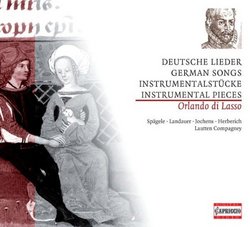| All Artists: Orlande de Lassus, Lautten Compagney, Mona Spagele, Wilfried Jochens Title: Orlando di Lasso: Deutsche Lieder; Instrumentalstücke Members Wishing: 0 Total Copies: 0 Label: Capriccio Release Date: 4/28/2009 Genres: Special Interest, Pop, Classical Styles: Vocal Pop, Opera & Classical Vocal, Chamber Music, Historical Periods, Classical (c.1770-1830) Number of Discs: 1 SwapaCD Credits: 1 UPC: 845221050119 |
Search - Orlande de Lassus, Lautten Compagney, Mona Spagele :: Orlando di Lasso: Deutsche Lieder; Instrumentalstücke
 | Orlande de Lassus, Lautten Compagney, Mona Spagele Orlando di Lasso: Deutsche Lieder; Instrumentalstücke Genres: Special Interest, Pop, Classical |
Larger Image |
CD Details |
CD ReviewsNot Quite.... Giordano Bruno | Wherever I am, I am. | 05/26/2009 (3 out of 5 stars) "Really topnotch performances of the music of Orlando di Lasso (Orlande de Lassus 1532-1594) are surprisingly scarce, considering the composer's stature in his own era and acclaim among musicians and musicologists of today. This recording, to my ears, exhibits all the typical shortcomings; it's technically proficient enough but it lacks zest. These little songs -- not all German, by the way, but also French and Italian -- should hop and chuckle, should exude "fun", and not sound like earnest art. Several of them have "suggestive' texts, and all of them are full of wit. WIT! That's the missing ingredient in so many performances of Lassus.
Lassus was possibly the only composer of the 16th Century who wrote songs -- Lieder, madrigals, chansons -- in the distinct musical idioms of German, Italian, and French. His German songs were chiefly written on commissions from patrons in Munich. especially the young Duke Wilhelm, heir apparent, who favored German as the language of Court over French. Lassus's Lieder are plainly in the tradition of the earlier music master of the Bavarian Court, Ludwig Senfl. Honestly, Lassus's Lieder are nowhere close to Senfl's in imagination or originality, but they were a very minor part of Lassus's output. Only Heinrich Isaac really rivaled Senfl in the genre of secular German songs. German songs of the 16th C were most often "Tenorlieder"; that is, the 'melody' (and the necessarily texted voice) is the tenor, and it was common to perform the higher and lower voices on instruments. That's the format chosen by the 'Lautten Compagney' ensemble for this performance. The choice of accompanying instruments was ad libitum; on this CD, several sizes of viola da gamba, several varieties of lute, and a single cornetto/zink are heard. Lassus himself wrote little or nothing specifically for instruments, but works of his were intabulated for lute and published during his lifetime. Some of those intabulations are recorded here. If the results sound a bit, at times, like "flat picking" on a guitar, one shouldn't be surprised. The lutes of the 16th Century were still occasionally played with a plectrum. I might have given this recording another star, for novelty and for being virtually the only choice available, but Capriccio has re-released this 1993 CD with NO TEXTS at all, not in any language. Where's the fun in hearing comic songs without any sense of the jokes! Authentic historical instruments are not enough to create an authentic experience of the music. To hear a ribald song about a 'fuller' - Un jour vis un foulon - whose fulling is suspiciously rhythmic, and to have it sound like a Protestant hymn, is not a fair presentation of that sly musical fox, Orlande de Lassus." |
